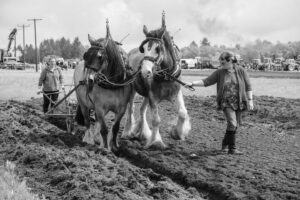In the second half of the 1870s when the chilled plough had been introduced into Scotland, there was considerable debate on its effectiveness including how much of a labour-saving implement it was. There were discussions in local and national agricultural societies as well as trials, demonstrations and new classes at ploughing matches. Reports of these were published in the Scottish agricultural press.
One such report was published in the North British Agriculturist, the most widely known agricultural newspaper in Scotland at this time, on 27 March 1889. It related to a discussion that took place at the Spey, Aven and Fiddichside Farmers’ Club. It is a really good account of the debates that farmers and agriculturists were having at this time. It lets the reader see what was important in the discussion and how they evaluated this new plough. It is worth quoting at length:
“Chilled versus swing ploughs
At a meeting of the Spey, Aven and Fiddichside Farmers’ Club last week, a very practical discussion took place on the relative merits of the chilled or American plough and the common swing plough. Mr Inkson, Kinermony, who introduced the subject, said he had tried the chilled plough, and the work it did was very satisfactory. It went deeper than the ordinary swing plough, and left nothing but what was turned over. The furrow, when turned over, was left entirely broken and loose, and the frost penetrated and pulverised the soil was very freely. When they came to harrowing after these ploughs, they would finish that a great deal less of that was required to produce the same effect as the other ploughs, and equally as good, if not a better, braird. Cross ploughing, or what was commonly called steering in the spring, was done with the American ploughs very satisfactorily. He had noticed the rigs which were ploughed with them had the best mould, and they were usually kept in the stiffest part of the field. This was of great consequence to the turnip crop. He had also ploughed lea and clean land with them, rig and rig alternately with the common plough, and he could not say that he knew any material difference in the crop. The American plough would do in the same time a half more work, and although turning a much bigger furrow, it had about a half less draught on the horses. It was also less costly to be maintained. He calculated from his own experience that there was. A saving in the blacksmith’s bill of at least £2 per plough per season when the chilled plough was used, as compared with the common plough. The majority of the speakers were in favour of the chilled ploughs, though it was generally admitted that they were not so good as the ordinary plough on rough land, and where there were many lodged stones or rocks. Mr Robertson, Aberlour Mains, believed the chilled plough to be far the best for stubble, but he would not care to use them on sandy lea. The soil was left too loose, and the drought might get in. The chilled ploughs effected a great saving in labour, and the draught was small. He had seen a pair of horses come in that had been working a common plough dripping with perspiration, and at the same time a pair working the chilled plough, and they had not a hair turned.
A chilled plough would pay itself in two seasons. They worked best on strong clay soil, which it broke and pulverised better than the ordinary plough, while it saved harrowing and gave a finer tilth for the seed. Mr Cruickshank, Dandaleith; Mr Stuart, Inverfiddoch; Mr Craig, Gauldwell, and others, spoke in favour of the American style of plough. A number of the farmers had not tried the chilled ploughs, and one or two said they did not intend to; but others objected to them on the ground that upon hard, rocky-bottomed soil they were very liable to break. Mr Cumming, Cardow, and Mr Stoddart, Grange, stated. More serious objection in their opinion, which was that in ploughing lea they left a bit of pan in the bottom of the furrow. The Chairman (Mr Alex Cameron, of Highfield, Elgin), in summing up, said there appeared to be considerable difference of opinion, even amongst practical men, as to whether the chilled plough made better work than the old plough; but it was quite clear to him the chilled plough was certainly economical in working, and that it made a great deal less labour to the horses than the old plough did.”
What do you think of their discussion?
The photos were taken at B. A. Stores, May 2019


